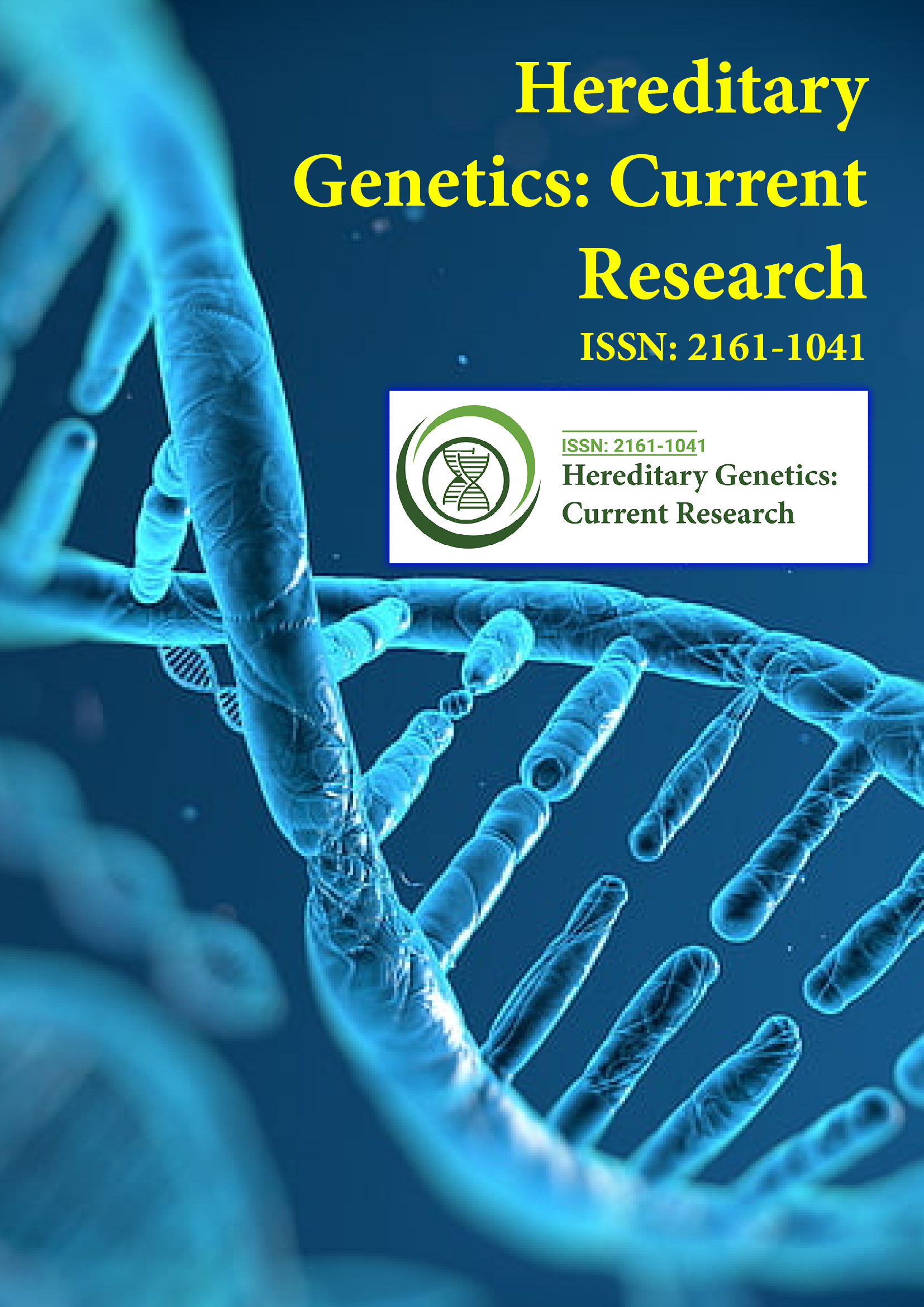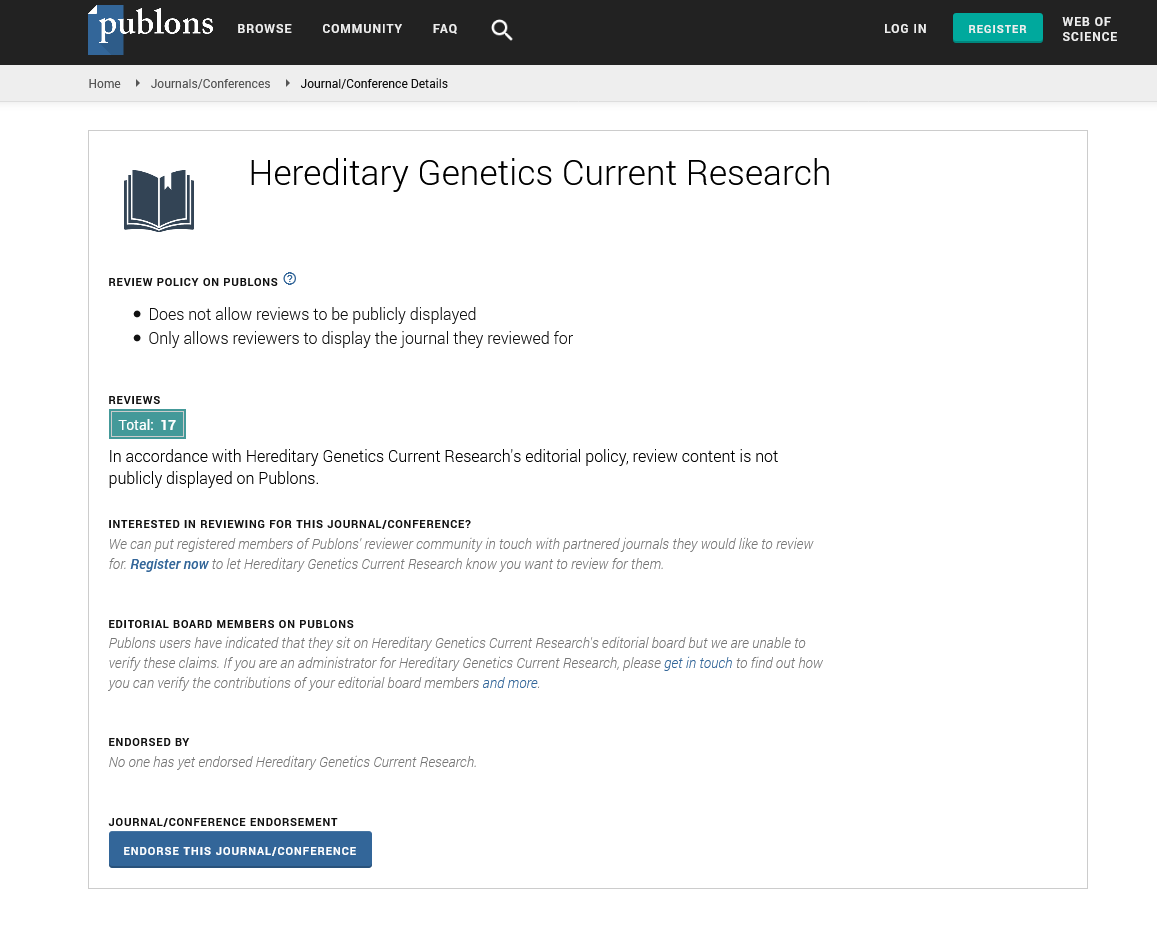Indexed In
- Open J Gate
- Genamics JournalSeek
- CiteFactor
- RefSeek
- Hamdard University
- EBSCO A-Z
- NSD - Norwegian Centre for Research Data
- OCLC- WorldCat
- Publons
- Geneva Foundation for Medical Education and Research
- Euro Pub
- Google Scholar
Useful Links
Share This Page
Journal Flyer

Open Access Journals
- Agri and Aquaculture
- Biochemistry
- Bioinformatics & Systems Biology
- Business & Management
- Chemistry
- Clinical Sciences
- Engineering
- Food & Nutrition
- General Science
- Genetics & Molecular Biology
- Immunology & Microbiology
- Medical Sciences
- Neuroscience & Psychology
- Nursing & Health Care
- Pharmaceutical Sciences
Commentary - (2023) Volume 12, Issue 1
Effect of Populations and Assessment of Molecular Tools in Genetic Diversity
Naoko Mori*Received: 06-Mar-2023, Manuscript No. HGCR-23-19959; Editor assigned: 09-Mar-2023, Pre QC No. HGCR-23-19959 (PQ); Reviewed: 23-Mar-2023, QC No. HGCR-23-19959; Revised: 30-Mar-2023, Manuscript No. HGCR-23-19959 (R); Published: 06-Apr-2023, DOI: 10.35248/2161-1041.23.12.233
Description
Genetic diversity is a trait that can be found in both individuals and populations and is defined by the percentage of heterozygous alleles in diploid organisms. All living things have genetic blueprints, which are like a unique genetic fingerprint. This holds true regardless of whether they are plants, animals, or fungi, how long they live, whether they reproduce sexually or asexually, and whether they are short-lived or long-lived. In order to restore living creatures, conservation, genetics, and conservation genetics all play significant roles. Although the fundamental idea behind conservation genetics may be well known, genetic issues in relation to conservation genetics have received very little attention. Any organism's ability to survive and reproduce as well as the health of populations are greatly influenced by genetic variety. Any population can be affected by genetic diversity and variability in a number of ways. The population's growth rate is reduced because of decreased fecundity and survival of inbred individuals, which increases the possibility that the population could become extinct in the very near future as a result of random events. Due to several environmental stresses and genetic bottlenecks that further inbreed the population and depress its mood, a population's capacity for population increase also reduces its ability to recover from a population crisis. Several factors have an impact on the population's fitness.
Therefore, a fall in genetic variation will eventually reduce the population's potential to develop in the face of a changing environment if population growth is insufficient to make up for the fitness loss. A trait's heritability is inversely correlated with the evolutionary response to selection, which is inversely correlated with the predicted heterozygosity of the gene diversity underlying that particular trait. Populations with genetic polymorphism in a number of alleles or with numerous alleles for a particular trait have excellent evolutionary flexibility. Therefore, a population that is less diversified and has less genetic diversity will presumably adapt more slowly and achieve less adaptation than a population that is more diverse and has more genetic diversity. As a result, a sudden increase in genetic variety in small populations can lower the pace of adaption to the point where small populations become extinct in the face of environmental changes to which big populations are likely to adapt. To maintain long-term survival potential, every population should be large enough to endure genetic erosion and the loss of genetic variation caused by genetic drift and genetic bottlenecks. Basically, mutations can affect the viability of small populations by causing inbreeding depression, by maintaining adaptive genetic variation in quantitative features, and by causing fitness to disintegrate due to the accumulation of slightly harmful mutations.
Assessment of molecular tools in genetic diversity
The most potent driving force in the field of conservation has been the development of genetics and molecular technologies, which have given rise to a wide range of molecular approaches for use in population genetic and conservation research. In conservation biology, molecular techniques have been widely used up until this point, principally as selectively neutral molecular instruments for answering the empirical concerns of conservation and evolutionary relevance.
The first step of molecular biological technologies in the field of conservation genetics was taken in 1960 with the introduction of protein polymorphism analysis. This was followed by the methodologies based on Mitochondrial DNA (mtDNA), Restriction Fragment Length Polymorphism (RFLP), randomly amplified polymorphic DNA, and more recently by technologies based on microsatellite markers, including Inter Simple Sequence Repeat (ISSR) markers, Diversity Array Technology (DArT), and other high throughput techniques. As a result, the uses of various types of genetic markers are becoming more and more specialised in order to accomplish a given task or address a particular issue related to conservation.
The successful sequencing of the evolutionary, ecological, and commercially significant model species' genomes marked the beginning of the "genomic age." Numerous advantages, such as a greater variety of molecular markers from various organisms, the high sophistication of SNP and microsatellite markers, and the additional use of neutral markers, improve the fidelity of conservation studies and allow researchers to delve deeply into issues pertaining to conservation concerns. Recent breakthroughs in genomic technology, such as Next Generation Sequencing (NGS) and "deep sequencing" or "ultra-high throughout sequencing" technologies, offer a wider perspective on how to comprehend empirical questions about the conservation genetics of model and non-model organisms.
Citation: Mori N (2023) Effect of Populations and Assessment of Molecular Tools in Genetic Diversity. Hereditary Genet. 12:233.
Copyright: ©2023 Mori N. This is an open-access article distributed under the terms of the Creative Commons Attribution License, which permits unrestricted use, distribution, and reproduction in any medium, provided the original author and source are credited.

